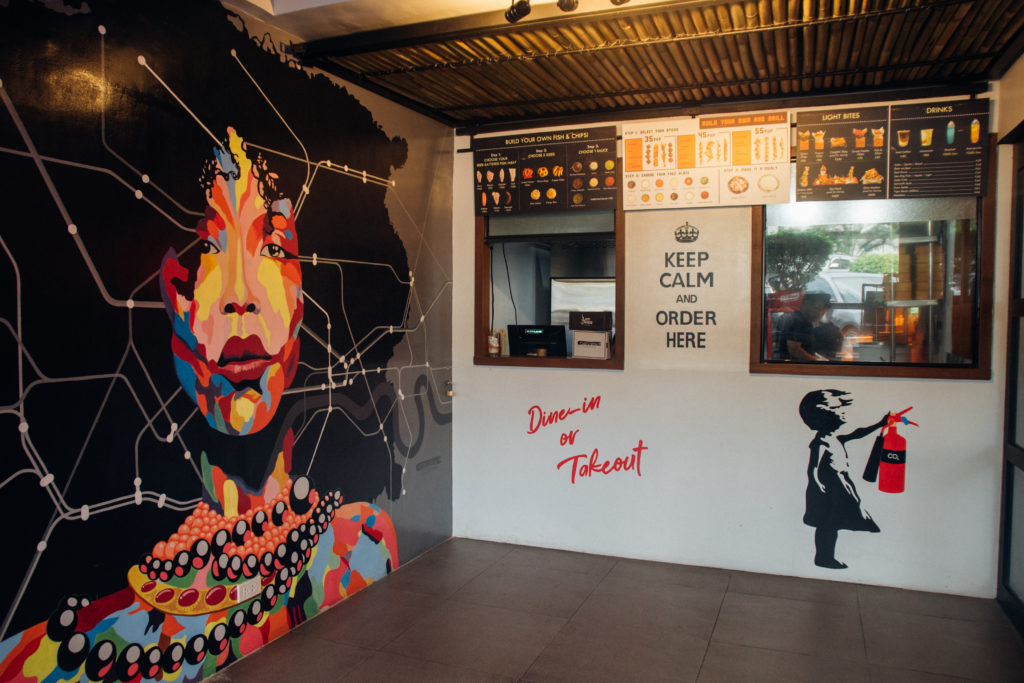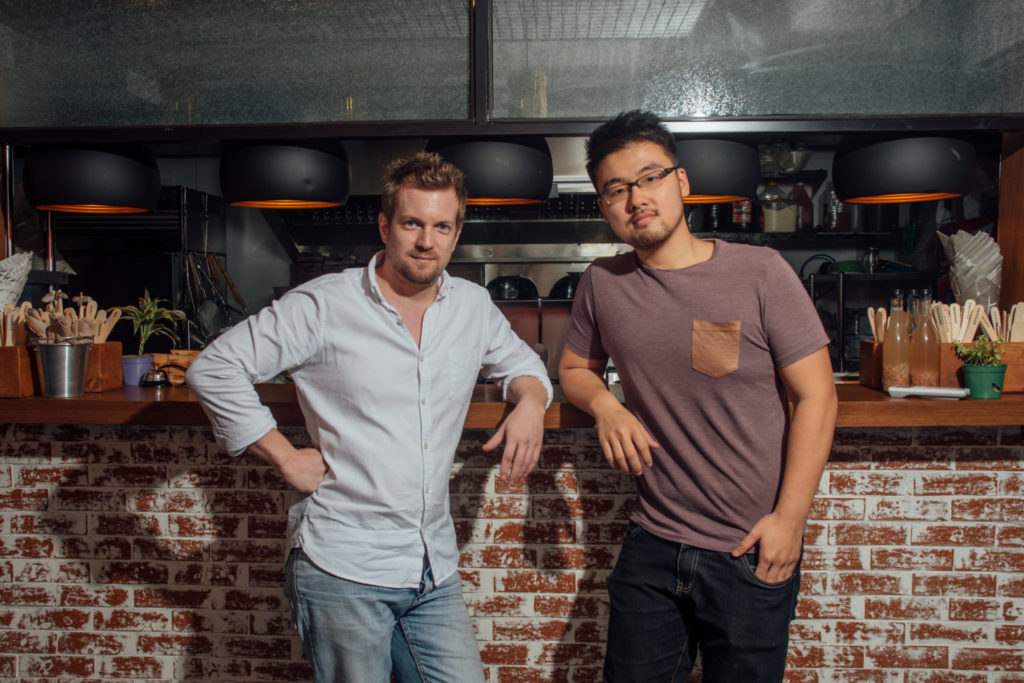The origins of Burnt Bamboo and CargoFish may appear to be on opposite ends of the world but their principles are virtually the same: to expertly anchor street food in a way that isn’t normally done these days.
Matthew Hornsby-Bates together with business partner Matthew Lim refine that approach with an ode to unconventional mixing and matching and a predisposition for options like pairing English fish and chips with rice or Pinoy barbecue with chimichurri. Yet this clash of cultures at Burnt Bamboo is an attraction in and of itself matched by an environment that borrows heavily from British culture—walls adorned with London Underground wallpaper, seductive neon signs, large-scale murals, a Banksy replica, and even a cozy little “beer garden.”
“It’s a British term,” says Hornsby-Bates. “In the UK, a lot of pubs would have a garden in the back where you go out and drink beer. It sounds nicer than ‘Can I put you out the back?’” It’s an interesting move, which makes this dual space iteration flex the idea of street food and bar chow in Manila. And it’s something that Hornsby-Bates has done ever since he first collaborated with Lim.
Create an experience


“I was missing the fish and chips back home,” Hornsby-Bate says. “I felt there wasn’t a [proper] fish and chips shop in Manila. There is but it seems to be very expensive. I wanted to do something more flexible and a takeaway as it was back home.”
CargoFish took a while to establish but it marked a change in how restaurateurs should find a niche in a foreign city. Because the spaces they were looking at were either too big or overpriced, Hornsby-Bates had to change his approach—to house the shop in a cargo container then pitch the idea to malls.
What becomes apparent is that a flexible menu might be a key strategy in presenting food that may be overdone. In Burnt Bamboo’s case where grilled meat sticks are available virtually anywhere in Manila, it’s experimentation with flavor profiles that prevails, turning banal street food into a bigger experience.
“Instead of looking for an actual space, we just sent them a concept,” he says. Then Kevin Tan of Megaworld Lifestyle Malls liked the idea. “That was really the big jump.” And it worked.
What was once initially a takeaway space that would serve BPO employees in the area (and a measly 20 seats to boot) has transformed into a watering hole that can now accommodate 110 customers, thanks to a campaign rooted in choices.
“There’s a bar aspect to it now,” Hornsby-Bates says. “People come to us and tend to hang out. It wasn’t just eat and go, which was my initial vision.” It’s a concept that Hornsby-Bates aims to replicate in City Golf Plaza with Burnt Bamboo.
Finding a niche
So how do you manage to recreate past success and introduce a new idea in a new location at the same time? The British native who had also worked in Switzerland and Italy before relocating to Manila eight years ago seems to have found the formula for breaking down barriers wherever he may be.
What makes Hornsby-Bates’ ideas click is that he creates a narrative of expectations around concepts that are relatable even among Filipinos. How? Because the idea is genuine and when done properly, it works. For instance, Burnt Bamboo’s meat sticks, while not groundbreaking, are entrenched in certain cultures. That is, Asian meat sticks like isaw, betamax, and pork belly sit comfortably next to Middle Eastern kofta, tenderloin, and chicken wings to form the menu’s foundation.
“When we were conceptualizing Burnt Bamboo, we were really trying out all these street foods,” he says. “We were going to markets and little corners all over the place to test out different barbecues. The twist is the flavors because we created glazes where you get to choose your flavor profile.”
The options are there to offer new experiences but the customer has the freedom to come to their own conclusions of what makes the ideal meat stick—whether or not they want to experiment or not.
The options are there to offer new experiences but the customer has the freedom to come to their own conclusions of what makes the ideal meat stick—whether or not they want to experiment or not. “It’s a simple thing but the customer should have that freedom,” says Hornsby-Bates.
What becomes apparent then is that a flexible menu might be a key strategy in presenting food that may be overdone. In Burnt Bamboo’s case where grilled meat sticks are available virtually anywhere in Manila, it’s experimentation with flavor profiles that prevails, turning banal street food into a bigger experience.
Lim however is quick to point out that establishing this type of menu came about as a result of disagreement. “That’s how we created Burnt Bamboo because we couldn’t agree on the flavors,” the Filipino-Chinese chef says. “He wants chimichurri, fresh flavors but Filipino palates are very strong so it needs to suit the Filipino palate. During the first few years [of CargoFish], he didn’t want to add rice [to fish and chips] because he said it was impossible for him but in the Philippines we needed to have rice. Now it’s one of our bestsellers.”
“We came up with 12 but never intended to keep 12,” Hornsby-Bates adds. “We were going to bring it down to six but the ones he wanted to remove were the ones I wanted to keep. It was never meant by design, it just ended up that way.”
A head start
Local and expat chefs can pick up a thing or two from Hornsby-Bates’ methods. Cooking a new life in a foreign city is much more based on acclimatizing and immersing into the culture without losing grip of your own identity. He is smart in that he carefully chose to work with Manila’s dining landscape, a terrain he was initially unfamiliar with and a city that is currently experiencing a deluge of restaurant openings from both local and foreign brands alike.
“Any city is going to change. Any city will have its trends and move forward,” he says when asked about the viability of Manila as a culinary destination. “Food trends happen like anything else in fashion. When it comes to CargoFish, I don’t really want to link it to food trends because the roots of the chip shop is very classic. In the UK, there’s a fish and chips shop in every street. Every family has a favorite that they patronize. You get friendly with the people, the staff and I’d like that to be the base for the way we work as well. It’s not about jumping onto necessarily a trend for the next six months to a year and let it die and change it to something else.”
While it’s too early to tell how Burnt Bamboo will play out since it’s also competing with a number of establishments in an arguably unforgiving property, what could possibly make it work is that it’s building off the style that made CargoFish a success. And with the 80-seater concept sharing space with the fish and chips takeaway shop, it may only be a matter of time before the market responds and make this idea stick.

